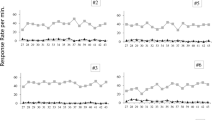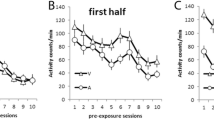Abstract
This experiment extends Pavlov’s method of contrasts for training a stimulus discrimination to the case of the cardiac conditional response in the rhesus monkey. It explores the parameter of temporal placement of an additional stimulus (“CS2”) within a 10-sec CS (or “CS1”), with the appearance of the former stimulus on any trial signalling the absence of UCS (electric shock) on that trial. This experimental paradigm is a parallel to that of the “intruded stimulus” studies in operant conditioning. In both cases, several ways of describing the function of the added stimulus are possible, but all seem reducible to the same operational terms. Data were taken in the present study with respect to the form and latency of the cardiac rate changes produced by intrusion of CS2 (light), across a range of placements varying from simultaneity with CS1 (a different light) onset to two sec before UCS would have been delivered. The control of CS2 over the cardiac rate CR was occasionally exhibited with a latency as short as three beats after stimulus onset. The order of CS2 temporal placements to which a subject was exposed was a factor in determining the form of the conditioned cardiac rate response to CS1.
Similar content being viewed by others
References
Bankart, C. P., and Elliott, R.: Heart rate and skin conductance in anticipation of shocks with varying probability of occurrence.Psychophysiology,11:160–174, 1974.
Bersh, P. J., Notterman, J. M., and Schoenfeld, W. N.: Extinction of a human cardiac-response during avoidance-conditioning.Am. J. Psychol.,69: 244–251, 1956.
Eckerman, D. A., and McGourty, D. P.: Varying temporal placement of response-produced stimuli in a fixed-interval schedule.Psychonom. Sci.,15:225–227, 1969.
Farmer, J., and Schoenfeld, W. N.: Varying temporal placement of an added stimulus in a fixed-interval schedule.J. Exp. Anal. Behav.,9:369–375, 1966a).
Farmer, J., and Schoenfeld, W. N.: The effect of a response-contingent stimulus introduced into a fixed-interval schedule at varying temporal placement.Psychonom. Sci.,6:15–16, 1966(b).
Miller, R. E., and Caul, W. F.: Influence of uncertainty on conditioned heart rates of monkeys.Physiol. Behav.,4:975–980, 1969.
Nathan, M. A., and Smith, O. A., Jr.: Differential conditional emotional and cardiovascular responses—A training technique for monkeys.J. Exp. Anal. Behav.,11:77–82, 1968.
Notterman, J. M., Schoenfeld, W. N., and Bersh, P. J.: Partial reinforcement and conditioned heart rate response in human subjects.Science,115: 77–79, 1952.
Pavlov, I. P.:Conditioned Reflexes. (Translated by G. V. Anrep). London: Oxford University Press, 1927. (Page reference in text is to paperback edition, New York: Dover Publications, 1960).
Ramsay, D. A.: Form and characteristics of the cardiovascular conditional response in rhesus monkeys.Cond. Reflex,5:36–51, 1970.
Ramsay, D. A.: Pavlovian differentiation of heart rate in the rhesus monkey.Acta Neurobiol. Exp.,31:1–11, 1971.
Ramsay, D. A., Pomerleau, O. F., and Snapper, A. G.: Two methods for obtaining electrocardiograms of chair-restrained monkeys.Cond. Reflex,3:200–204, 1968.
Schoenfeld, W. N., Kadden, R. M., and McMillan, J. C.: Cardiac conditioning and extinction inMacaca mulatto during block of the CR by cardiac pacing.Pav. J. Biol. Sci.,9:1–16, 1974.
Snapper, A. G., and Kadden, R. M.: Time-sharing in a small computer based on a behavioral notation system.In B. Weiss (Ed.)Digital Computers in the Behavioral Laboratory. New York, Appleton-Century-Crofts, 1973.
Snapper, A. G., Pomerleau, O. F., and Schoenfeld, W. N.: Similarity of cardiac CR forms in the rhesus monkey during several experimental procedures.Cond. Reflex,4:212–220, 1969.
Snapper, A. G., Schoenfeld, W. N., and Shimoff, E. H.: Varying temporal location and intensity of an added electrical stimulus in a fixed-interval schedule.Proceedings, 79th Ann. Convention, Am. Psychol. Assoc., 705– 706, 1971.
Author information
Authors and Affiliations
Additional information
Portions of this study were reported at the 81st Annual Convention of the American Psychological Association, Montreal, 1973. The study was supported by the National Institute of Mental Health under Grant MH-13049, and by the Veterans Administration Hospital, Montrose, New York. Reprints may be obtained from: Psychology Research Laboratory, Building 7, Room 19, FDR VA Hospital, Montrose, New York 10548.
Rights and permissions
About this article
Cite this article
Kadden, R.M., Washton, A.M., McMillan, J.C. et al. Varying temporal placement during CS of an added stimulus correlated with non-delivery of UCS. Pav. J. Biol. Sci. 10, 76–84 (1975). https://doi.org/10.1007/BF03001151
Issue Date:
DOI: https://doi.org/10.1007/BF03001151




